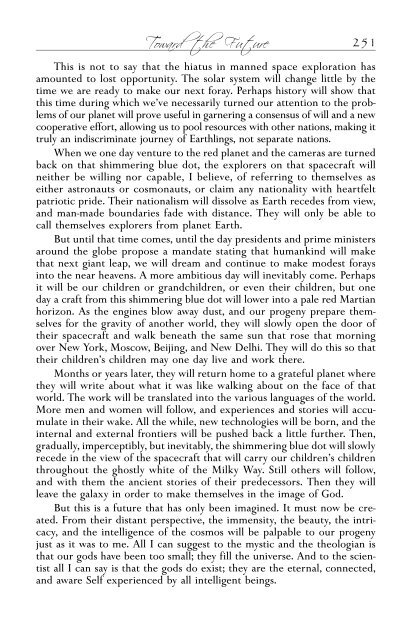edgar-mitchell
edgar-mitchell
edgar-mitchell
You also want an ePaper? Increase the reach of your titles
YUMPU automatically turns print PDFs into web optimized ePapers that Google loves.
126<br />
The Way of the Explorer<br />
as a wave. However, since the later Greek thinkers, it was believed to be<br />
corpuscular or particle-like, and from Galileo to Newton onward for three<br />
centuries, the argument persisted. One side or the other would prevail,<br />
but only for a time, as new discoveries were made, lending credence to the<br />
opposing camp. Then by 1880, James Clerk Maxwell and his electromagnetic<br />
theory seemed to definitively settle the issue. His theory claimed that<br />
light was most certainly wavelike. Of course, this too passed.<br />
With the discovery of the photo-electric effect by Philipp von Lenard<br />
in 1902, and the solution to quantized heat radiation by Max Planck, the<br />
pendulous answer again began to swing toward Newton and those who<br />
believed light was a particle. It was Einstein, still an unknown in 1905,<br />
who put the wave and particle ideas together, with the mathematics to<br />
show that light came in little packets of energy, subsequently called photons,<br />
each carrying a quantum of energy proportional to the frequency of<br />
the light. Light, and all radiation, clearly had both wave and particle characteristics.<br />
Einstein had cobbled together concepts previously considered<br />
separate.<br />
A few years later, Louis de Broglie asserted that not only light, but all<br />
matter possessed both wave and particle properties at the subatomic level.<br />
That is to say, he brought into question the fundamental way matter was<br />
believed to exist. Atoms were not like little ping-pong balls after all. This<br />
brought us to the strange new world of quantum physics, an eerie world so<br />
baffling and mysterious that both Einstein and Planck had difficulty accepting<br />
it until the very end of their lives.<br />
The dual nature of matter as both particle and wave is the foundation<br />
of quantum physics; we now call it the wave/particle duality. 1 Since the<br />
days of Newton, waves and particles have been given precisely definable<br />
and measurable attributes, though the definiteness of the attributes of each<br />
are quite different. Particles may be said to have a definite position, mass,<br />
velocity, and spin. Their momentum and energy are attributes that can be<br />
computed. However, waves have no mass, no definite position, nor spin.<br />
Waves can also overlap constructively or destructively (in other words,<br />
coexist at the same location)—matter cannot. But waves do have polarization,<br />
energy proportional to frequency, and a constant velocity (the speed<br />
of light in free space). These different attributes and their measures were<br />
and are a source of consternation to many physicists. How can such different<br />
concepts be brought together<br />
Einstein resolved one critical issue even before the ascension of quantum<br />
theory by postulating that the energy equivalent of matter at rest was<br />
the product of its mass and the velocity of light squared, expressed in his<br />
famous equation, E=MC 2 . This equation helped relate the energy of waves<br />
to that of particles: Energy (waves) equals mass (particles) multiplied by


